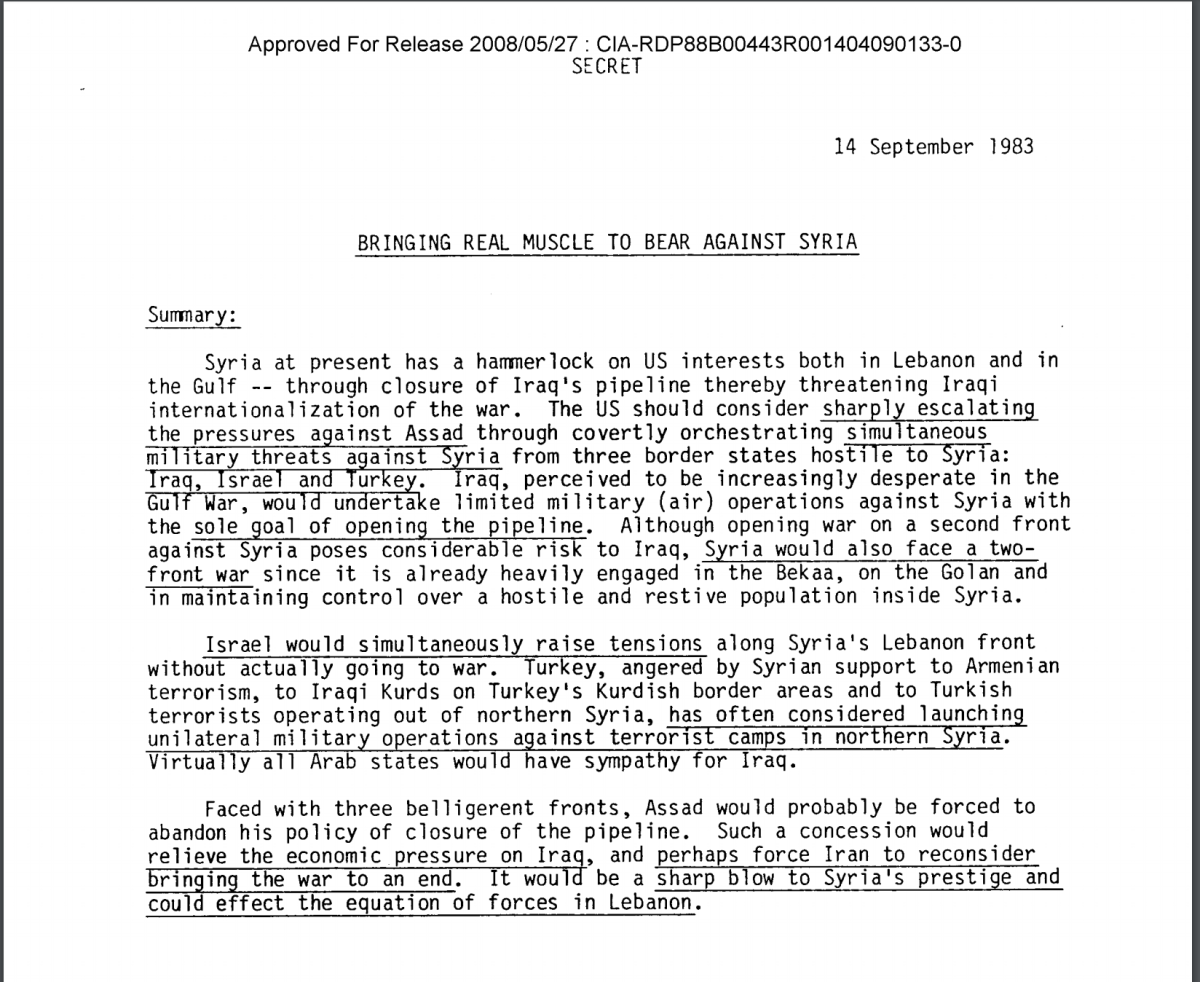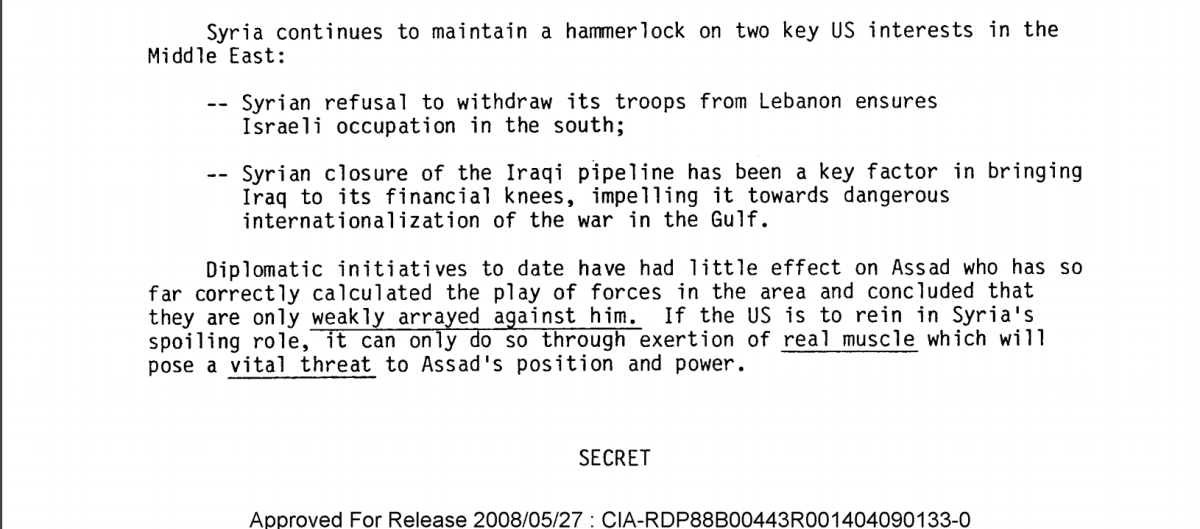Declassified CIA Document Reveals Plan To Destroy Syria For Oil Pipeline, Crisis Imminent
By
Posted on
A CIA document from the early 1980s details the US plan to destroy Syria — in much the same way the United States is doing now.

President Donald Trump has repeatedly castigated President Bashar al-Assad for ordering a gruesome mass killing of civilians with chemical weapons in Khan Sheikhoun. This accusation, unsubstantiated due to lack of investigation, sparked a bolstering of support for the Syrian regime from both Moscow and Tehran.
Were the account of an ordered chemical weapons attack to prove unassailably true — and Assad isn’t exactly known for being a gentle despot — Trump could have handily earned a congressional green light and perhaps approval from NATO to obliterate Syrian Arab Army forces responsible. Perhaps.
Yet — images of deceased children, women, and men still echoing in shock waves around the planet — the reality show host-turned American President, tellingly, did neither.
Fifty-nine $1.87 million Tomahawk missiles raining down on a Syrian air base not long after the ostensive toxic gassing answered with finality whether Trump would fall in line with a succession of pompously bellicose presidents — as well as whether the neocon political establishment’s longstanding mission to forcibly bend Syria to its will.
“Syria at present has a hammerlock on US interests both in Lebanon and in the Gulf — through the closure of Iraq’s pipeline thereby threatening Iraqi internationalization of the war. The US should consider sharply escalating the pressures against Assad through covertly orchestrating simultaneous military threats against Syria from three border states hostile to Syria: Iraq, Israel, and Turkey.”

Fuller’s analysis, points out Activist Post’s Brandon Turbeville, evinces Assad as a nuisance hindering American empire’s lust to control vast fossil fuel stores and protect ally, Israel, against multiple threats in the Middle East. Destabilization of Iraq and Iran also features prominently in the intricate U.S. plan to deal with the irritant, elder Assad — who, incidentally, recognized Western ulterior motives for what they were.
As the six-page document continues,
Syria continues to maintain a hammerlock on two key U.S. interests in the Middle East:
— Syrian refusal to withdraw its troops from Lebanon ensures Israeli occupation in the south;
— Syrian closure of the Iraqi pipeline has been a key factor in bringing Iraq to its financial knees, impelling it towards dangerous internationalization of the war in the Gulf.
Diplomatic initiatives to date have had little effect on Assad who has so far correctly calculated the play of forces in the area and concluded that they are only weakly arrayed against him. If the U.S. is to rein in Syria’s spoiling role, it can only do so through the exertion of real muscle which will pose a vital threat to Assad’s position and power.

With Iraq seeking to enjoin support internationally in the war, the U.S. had to scramble to prevent the shutdown of a pipeline — a dilemma Fuller suggests could be alleviated through a change in narrative to present Syria as a more deviant enemy than even Iran. That, alone, would have changed the face of the war bearing the names of the two principal adversaries — Sunni majority, Iraq, and Syria-allied, Shi’a, Iran.
Fuller asserted,
“The US should consider urging Iraq to take the war to the other key source of its predicament: Syria.”
Further, he continued,
“The US should consider sharply escalating the pressures against Assad [Sr.] through covertly orchestrating simultaneous military threats against Syria from three border states hostile to Syria: Iraq, Israel, and Turkey. Iraq, perceived to be increasingly desperate in the Gulf war, would undertake limited military (air) operations against Syria with the sole goal of opening the pipeline. Although the opening war on a second front against Syria poses considerable risk to Iraq, Syria would also face a two-front war since it is already heavily engaged in the Bekaa, on the Golan and in maintaining control over a hostile and restive population inside Syria.
“Israel would simultaneously raise tensions along Syria’s Lebanon front without actually going to war. Turkey, angered by Syrian support to Armenian terrorism, to Iraqi Kurds on Turkey’s Kurdish border areas and to Turkish terrorists operating out of northern Syria, has often considered launching unilateral military operations against terrorist camps in northern Syria. Virtually all Arab states would have sympathy for Iraq.
“Faced with three belligerent fronts, Assad would probably be forced to abandon his policy of closure of the pipeline. Such a concession would relieve the economic pressure on Iraq, and perhaps force Iran to reconsider bringing the war to an end. It would be a sharpening blow to Syria’s prestige and could affect the equation of forces in Lebanon.”In context, then-President Ronald Reagan faced pressure both to insert military power in Lebanon — a theater of stated neutrality for the U.S. — and to prohibit actual military assistance in the fraught regional entanglement.
That is until a suicide bomber decimated a U.S. Marines barracks encamped at an airport in Beirut, killing hundreds — just one month subsequent to the date on Fuller’s Syria action plan.
Micah Zenko, Senior Fellow at the Council on Foreign Relations — an albeit establishment- and Deep State-connected think tank — in “When America Attacked Syria,” wrote in 2012:
“The October 23, 1983, suicide truck bombing of the Marine barracks at the Beirut International Airport would kill 241 U.S. military personnel; simultaneously, another suicide bomber killed fifty-eight French servicemen of the MNF several kilometers away. (Two weeks later, yet another truck bomb exploded in the Israeli military headquarters in Tyre, killing sixty.) A FBI forensics assessment called the Marine barracks bombing the ‘biggest non-nuclear explosion since World War II.’ According to a Pentagon commission formed to investigate the attack, it was ‘tantamount to an act of war using the medium of terrorism.’ Within weeks, the CIA determined that ‘the bombings…of the United States and French MNF headquarters were carried out by Shia radicals, armed, trained, and directed by Syria and Iran.’”That the CIA — master meddler in the affairs of sovereign nations — determined fault for the bombings rested with Syria and Iran left both plausibly responsible, with public perception largely following suit.
That a situation eerily similar — in behind-the-scenes string-pulling and long-term U.S. commitment to deposing an Assad from the rule in Syria — appears to be playing out nearly three-and-a-half decades later, bellows resoundingly on failures of interventionist foreign policy.
Or, perhaps, it’s successes.
“Such a threat must be primarily military in nature. At present, there are three relatively hostile elements around Syria’s borders: Israel, Iraq, and Turkey. Consideration must be given to orchestrating a credible military threat against Syria in order to induce at least some moderate change in its policies,” Fuller explained in the document. “This paper proposes a serious examination of the use of all three states – acting independently – to exert the necessary threat. Use of any one state in isolation cannot create such a credible threat.”
To make proud the neocon war hawks ravenous to rain missiles upon Assad’s forces would duly emblazon the already blood-tinged U.S. government as the chief aggressor in a conflict that had been nearing resolution — if not, ultimately, the catalyst for the third world war.
To withdraw militarily and negotiate a reasonable conclusion to the quagmire in Syria, would mean admitting defeat in the removal of Assad — as well as a black eye from the propaganda-suckered who find solace in the Western policy of killing people to teach people killing people is wrong.
In fact, for Trump and his ilk to save face over Syria and prevent the increasing likelihood of direct military conflict with Russia seems an impossibility at this late hour.
In only the past week, incessant drums of war reached a frenetic and dizzying pace — met only by the furious uproar over yet another theater of war — despite Syria unofficially having been precisely that for the United States for decades.
Adve
No comments:
Post a Comment